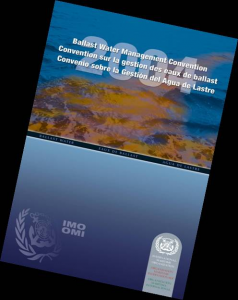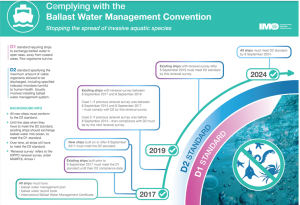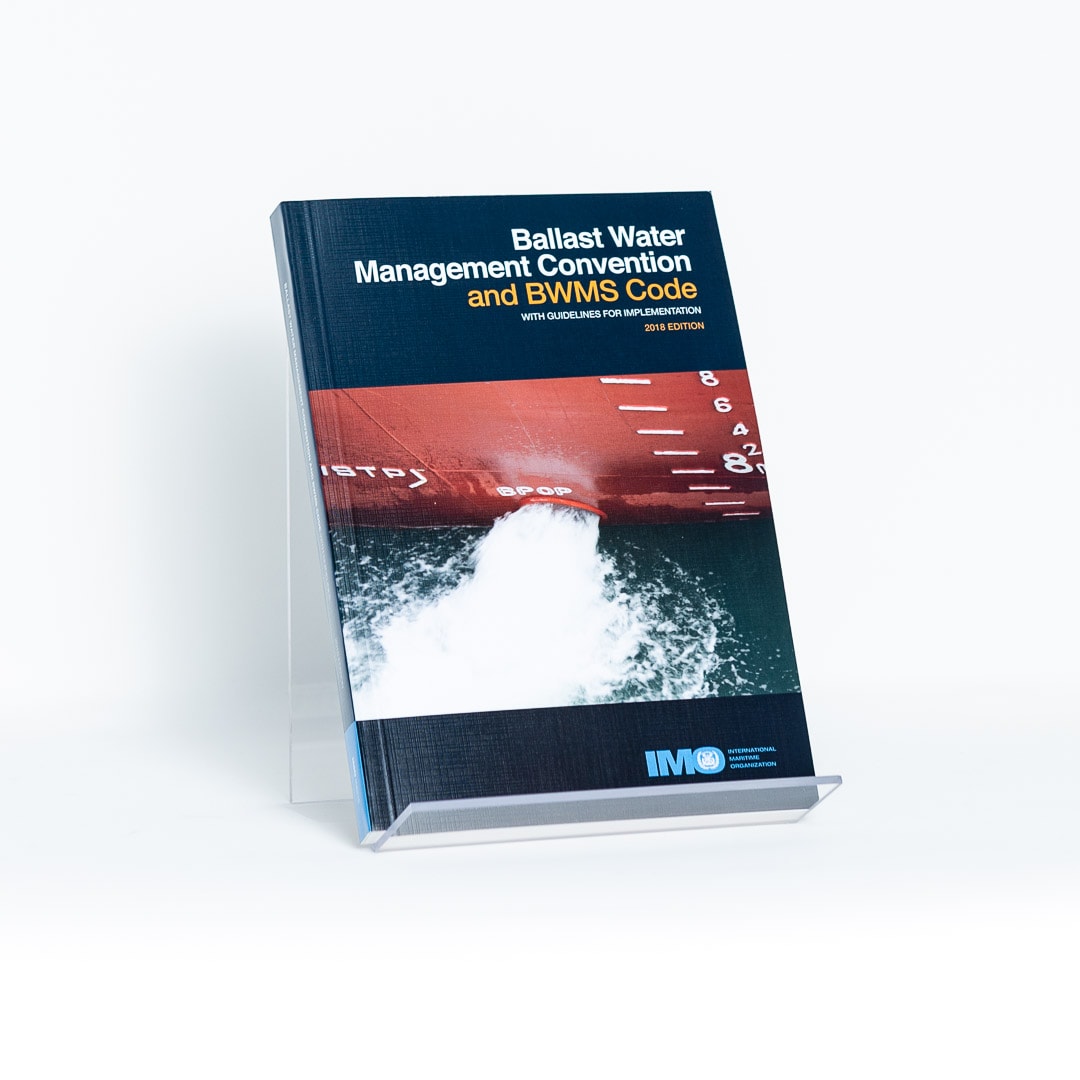Ballast water plays a crucial role in stabilizing ships during voyages, but it also poses a significant environmental risk by transporting invasive aquatic species across different ecosystems. The Ballast Water Management (BWM) Convention, adopted by the International Maritime Organization (IMO) in 2004 and enforced since September 8, 2017, aims to mitigate this problem. However, over the years, questions have arisen regarding the effectiveness of these measures. In this article, we examine the latest updates on ballast water management, the challenges faced by the maritime industry, and emerging technologies that improve compliance and environmental protection.
 After more than 14 years of complex negotiations between IMO Member States, the International Convention for the Control and Management of Ships’ Ballast Water and Sediments (BWM Convention) was adopted by consensus at a Diplomatic Conference held at IMO Headquarters in London on 13 February 2004.
After more than 14 years of complex negotiations between IMO Member States, the International Convention for the Control and Management of Ships’ Ballast Water and Sediments (BWM Convention) was adopted by consensus at a Diplomatic Conference held at IMO Headquarters in London on 13 February 2004.
The Convention requires all ships to implement a ballast water management plan. All ships have to carry a ballast water record book and are required to carry out ballast water management procedures to a given standard. Parties to the Convention are given the option to take additional measures which are subject to criteria set out in the Convention and to IMO guidelines.
The Environmental Impact of Ballast Water Discharge
Ballast water discharge poses significant environmental risks by introducing non-native species into marine ecosystems, leading to ecological imbalances and economic damage. Notable examples include Zebra Mussels in the Great Lakes, which have outcompeted native species and caused infrastructure issues; Asian Kelp in California, disrupting local biodiversity; and North American Comb Jellyfish in the Black Sea, which devastated fish populations. Despite the International Maritime Organization’s (IMO) regulations, gaps in monitoring and compliance allow some invasive species to persist, highlighting the need for stricter enforcement and innovative solutions to mitigate these impacts.

Ballast water can introduce non-native species into marine environments, leading to severe ecological and economic consequences. Notable examples include:
- Zebra Mussels in the Great Lakes, which have outcompeted native species and clogged water intake pipes, causing millions in damages.
- Asian Kelp in California, which has disrupted local marine biodiversity.
- North American Comb Jellyfish in the Black Sea, which decimated local fish populations due to its rapid reproduction.
Despite the IMO’s regulations, studies indicate that some invasive species continue to thrive due to gaps in monitoring and compliance.
Advances in Ballast Water Treatment Technologies
To meet the BWM Convention standards, shipowners have adopted advanced ballast water treatment systems. Key solutions include filtration systems to remove particles, UV irradiation to neutralize microorganisms, ozonation to break down contaminants, electrochlorination for disinfection, and ultrasound or hydrodynamic cavitation to destroy organisms. However, challenges persist, such as the regrowth of microorganisms in ballast tanks, as some species can survive treatment and recolonize. Continuous monitoring and innovation are essential to ensure effective and sustainable ballast water management. To comply with the BWM Convention, shipowners have implemented various ballast water treatment systems. The most effective solutions include:
- Filtration Systems – Removing particles and organisms before water is discharged.
- Ultraviolet (UV) Irradiation – Using UV light to neutralize microorganisms.
- Ozonation – Employing ozone gas to break down biological contaminants.
- Electrochlorination – Generating chlorine from seawater to disinfect ballast water.
- Ultrasound and Hydrodynamic Cavitation – Destroying organisms through high-frequency sound waves and pressure fluctuations.
Despite these advancements, regrowth of microorganisms inside ballast tanks remains a challenge. Some species can survive treatment and recolonize the water, making continuous monitoring essential.
Compliance and Enforcement Challenges
Despite advancements in ballast water treatment systems, enforcement remains inconsistent globally. Challenges include varying local regulations, high retrofitting costs for shipowners, and limited inspection capabilities by authorities. As of now, not all flags representing the global tonnage percentage have approved and signed the BWM Convention, further complicating uniform implementation. To address these issues, digital tracking and remote monitoring technologies are being explored to enhance real-time compliance and ensure effective enforcement across ports.
While ballast water treatment systems are becoming more sophisticated, enforcement remains inconsistent across global ports. Some key challenges include:
- Variations in Local Regulations – Different regions have their own compliance requirements, complicating implementation.
- High Costs for Shipowners – Retrofitting older ships with ballast water treatment systems can be expensive, discouraging widespread adoption.
- Limited Inspection Capabilities – Authorities often lack the resources to inspect every vessel thoroughly.
To improve enforcement, digital tracking and remote monitoring technologies are being explored to ensure real-time compliance.
–Approval of BWM systems
The BWM Convention requires that ballast water management systems used, to comply with the Convention, must be approved by the Administration taking into account the Guidelines for approval of ballast water management systems (G8).

Regional Initiatives and Success Stories
Certain regions have demonstrated success in reducing invasive species through strict regulations and innovative solutions:
- Great Lakes Protection Fund – Developed ballast water filtration systems and conducted extensive monitoring.
- European Union Directives – Mandated stringent ballast water discharge standards to protect marine ecosystems.
- U.S. Coast Guard Regulations – Implemented robust compliance checks for vessels entering American waters.
BWMS Code and documentation to be on board
To issue the IBWM certificate, the following documents must be verified onboard: the Type Approval Certificate (TAC) of the BWMS, the Operation, Maintenance, and Safety manual, the BWM plan, and installation specifications such as drawings and commissioning procedures. These documents ensure compliance with the BWMS Code and proper functioning of the ballast water management system. The following documentation should be verified to be onboard as a precondition to issuing the IBWM certificate:
- A copy of the Type Approval Certificate (TAC) of the BWMS
- Operation, Maintenance and Safety manual of the BWMS
- BWM plan
- Installation specifications, e.g. installation drawing, piping and instrumentation diagrams
- Installation commissioning procedures
The Future of Ballast Water Management
As climate change alters marine conditions, new challenges in ballast water management will emerge. Future efforts must focus on:
- Enhancing Global Standardization – Aligning regional policies to streamline compliance.
- Developing Smart Monitoring Systems – Using AI and IoT to track ballast water quality in real time.
- Encouraging Industry Collaboration – Engaging shipowners, researchers, and policymakers to refine best practices.
The Ballast Water Management Convention has made significant strides in addressing invasive species transport, but its effectiveness remains an ongoing concern. Advances in technology and stricter enforcement measures will be crucial in ensuring that ballast water management truly protects marine biodiversity. As the maritime industry continues to evolve, sustainable and innovative solutions will shape the future of global ballast water practices. By staying informed about regulatory updates and investing in efficient ballast water treatment systems, ship operators can contribute to a healthier marine environment while ensuring compliance with international standards.–
Here are three multiple-choice questions for ship cadets and students based on the refined article:
Question 1:
Which of the following is a major environmental risk associated with ballast water discharge?
A) Increased ship fuel consumption
B) Introduction of invasive species into new ecosystems
C) Rising sea levels
D) Reduction in port congestion
Question 2:
Which ballast water treatment technology uses high-frequency sound waves to destroy microorganisms?
A) Filtration systems
B) Ultraviolet (UV) irradiation
C) Electrochlorination
D) Ultrasound and hydrodynamic cavitation
Question 3:
What is one of the major challenges in enforcing ballast water management regulations?
A) Lack of interest from shipowners
B) Inconsistent regulations across different regions
C) Overpopulation of marine life
D) Excessive freshwater consumption by ships
BdB
Frequently asked Questions about BWM Convention
What is the Ballast Water Management Convention?
The BWM Convention, adopted by the IMO in 2004, aims to prevent the spread of harmful aquatic organisms and pathogens through ships’ ballast water. Since 8 September 2017, ships must manage ballast water to remove or neutralize these organisms before discharge, reducing the risk of invasive species and pathogens.
When did the BWM Convention enter into force?
The BWM Convention entered into force globally on 8 September 2017.
Which ships does the convention apply to?
The convention applies to ships registered under contracting Parties that use ballast water during international voyages.
What about ships under non-ratifying flags?
Ships under non-ratifying flags may not receive certificates but must still comply with the convention to avoid unfavorable treatment in ports of contracting Parties.
What do ships need to do now?
Ships must manage ballast water and sediments according to a ship-specific plan, carry a Ballast Water Management Plan, a Ballast Water Record Book, and an International Ballast Water Management Certificate (for ships ≥400 gt).
What are the ballast water management standards?
The D-1 standard requires ballast water exchange in open seas, while the D-2 standard limits viable organisms and harmful microbes in discharged water. New ships must meet D-2, while existing ships must meet D-1 until their compliance date.
What is the implementation schedule?
Compliance with the D-2 standard is phased in, with all ships required to meet it by 8 September 2024. New ships must comply immediately, while existing ships align with their IOPPC renewal surveys.
What if a ship doesn’t have an IOPPC renewal survey?
The ship must meet the D-2 standard by a date set by its flag State, no later than 8 September 2024.
What is the difference between D-1 and D-2?
D-1 requires ballast water exchange, while D-2 sets limits on viable organisms and harmful microbes in discharged water.
How is compliance checked?
Port State control inspections may verify certificates, management plans, record books, and ballast water sampling, following IMO guidelines.
How are ballast water management systems approved?
Systems must be approved by the Administration under IMO Guidelines, with additional approval required for systems using Active Substances.
Has implementation been delayed?
The D-2 standard was phased in to address delays in ratification, ensuring a practical approach to implementation.
Will there be further amendments?
The MEPC has established an experience-building phase to gather data and propose amendments, with potential updates considered at MEPC 79 in 2022.
Source: IMO
- IMO Circular Letter No.4204/Add.1 (PDF)
- IMO Circular Letter No.4204/Add.7 (PDF)
- IMO Circular Letter No.4204/Add.19 (PDF)


Thanks for sharing. I read many of your blog posts, cool, your blog is very good.
Highly descriptive blog, I enjoyed that a lot. Will there be a
part 2?
Your point of view caught my eye and was very interesting. Thanks. I have a question for you.